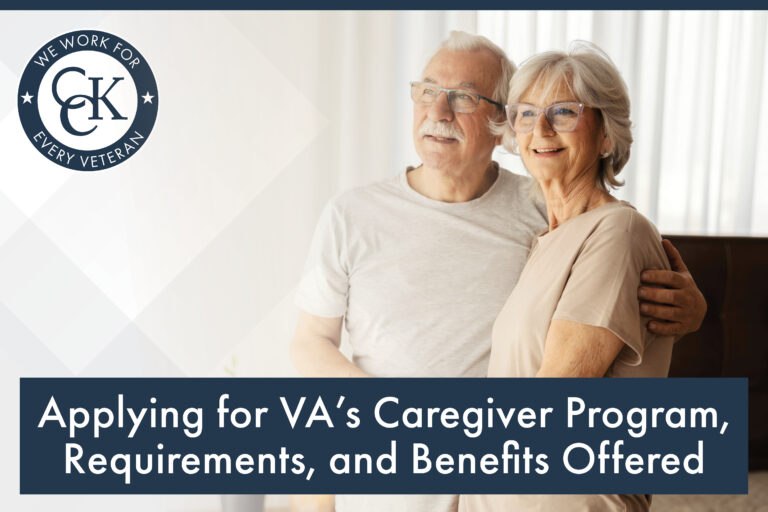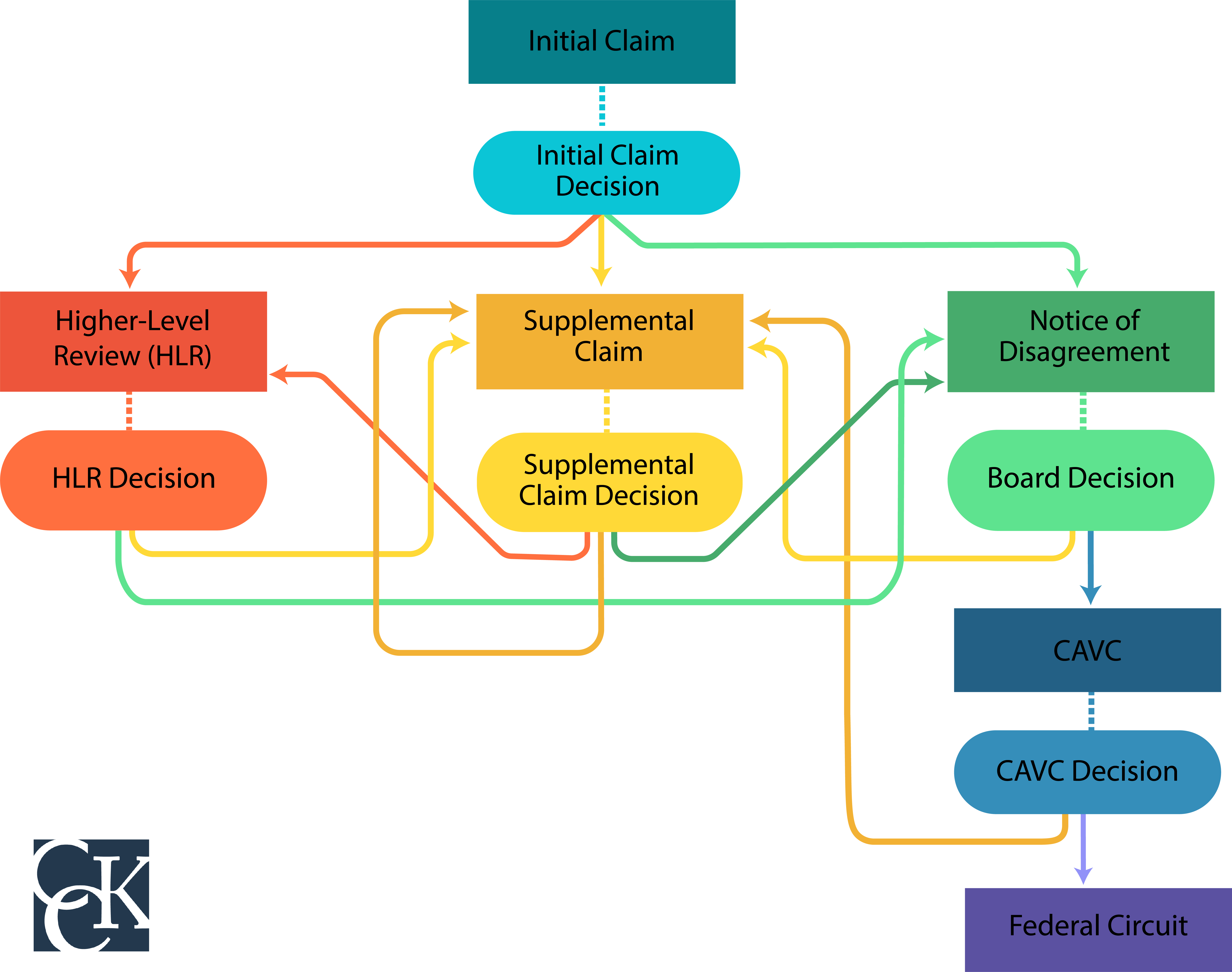Applying for VA’s Caregiver Program, Requirements, and Benefits Offered

CCK Law: Our Vital Role in Veterans Law
The VA Caregiver Program offers benefits for veterans who need assistance. There are specific requirements veterans must meet to be eligible for the program. Continue reading to learn more.
What is the Caregivers Program?
The VA Mission Act, or the VA Maintaining Internal Systems and Strengthening Integrated Outside Networks Act, was fully implemented in June of 2019. The $52 billion bill was passed with the intention of overhauling veterans’ access to private healthcare, including caregiver benefits nationwide.
The Caregiver Program, or Comprehensive Assistance for Family Caregivers, was initially established in 2011 to provide benefits to caregivers of post-9/11 disabled veterans. A caregiver specifically refers to someone who leaves their job to care for the veteran full-time due to the nature of the veteran’s disability. Typically, this person is a spouse or family member.
The program provides the caregiver with monthly compensation, medical training, healthcare benefits, and respite. VA also acknowledges that caregivers play a critical role in the health and well-being of veterans.
Common Disabilities that Can Require Full-Time Care:
- TBI, or Traumatic Brain Injury
- PTSD, or Post-Traumatic Stress Disorder
- Amputation or Loss of limbs
- Paralysis
- Blindness or impairment in vision
- Deafness
Eligibility Requirements for the Caregiver Program
In order to qualify for the program, there are requirements that both the veteran and caregiver must meet. Additionally, the expansion of the Mission Act, which began on October 1, 2020, has created two phases to expand the program’s offerings.
- Phase One—This phase, effective October 1, 2020, allows family caregivers of veterans who were seriously injured in the line of duty on or after May 7, 1975 to be eligible for the program.
- Phase Two—This phase, which will be effective after two years, will allow family caregivers of veterans who were seriously injured in the line of duty between May 7, 1975, and September 10, 2001, to become eligible.
Previously, only the caregivers of veterans who were seriously injured post-9/11 were eligible for this program. Eligibility for the program is made by the Veterans Healthcare Administration and caregivers may appeal decisions that deny their eligibility.
Eligibility for Caregivers:
In order to qualify for the program, the caregiver assisting the veteran must meet the following qualifications:
- Be at least 18 years old;
- Be the spouse, child, parent, stepparent, step-child, or extended family member of the veteran; AND
- Live with the veteran full time or be willing to if designated as the family caregiver.
Veteran Eligibility for Caregiver Assistance
In order for the veteran to qualify for the caregiver program, the veteran must:
- Be a veteran, or member of the armed forces, undergoing a medical discharge
- Have an individual or combined VA disability rating of 70 percent or higher
- Have served during one of the following time periods:
- On or after September 11, 2001, OR;
- On or before May 7, 1975
- Have service-connected disabilities which were caused or aggravated by active duty service
- Need at least six months of continuous, in-person personal care services
What are Personal Care Services?
Personal care services refer to the services a caregiver may provide to a veteran to assist with their Activities of Daily Living, or ADLs. VA outlines that caregivers should assist veterans with personal care services when the veteran is unable to perform these tasks themselves. This may include assisting with any of the following:
- Bathing or personal grooming
- Dressing and undressing
- Eating and preparing food
- Adjusting a prosthetic or orthopedic device or assisting the veteran with their mobility
- Supporting the veteran’s safety, which can occur in instances where the veteran may harm themselves without assistance
- Aiding the veteran through instruction regarding their daily living environment
- Supporting the veteran’s day to day life

Scenarios Which Indicate the Veteran Needs Personal Care Services
VA has four scenarios which can indicate that the veteran is in need of personal care services. In order for VA to determine that the veteran requires these services, the veteran only needs to identify with one of the following scenarios:
- The veteran is unable to perform one or more of the Activities of Daily Living (ADLs). Examples of these could include brushing one’s teeth, bathing, eating, cooking or cleaning.
- The veteran demonstrates a need for supervision, protection, or assistance based on the symptoms or residuals of a disability. This could include neurological impairments or other impairments or injuries. Specifically, these impairments, injuries, or residuals could stem from a Traumatic Brain Injury, PTSD, or a mental disorder.
- The veteran was awarded service connection for a serious injury that incurred or was aggravated in the line of duty, AND has been rated 100 percent disabled for that injury, AND has been awarded SMC that includes an allowance for aid and attendance.
- The veteran has a serious injury that is a psychological trauma or mental disorder, AND has received a Global Assessment of Functioning (GAF) score of 30 or less continuously for a 90-day period immediately preceding VA’s receipt of the application for a caregiver.
Compensation and Pension Exams (C&P) for the VA Caregiver Program
When applying for the VA Caregiver program, VA might schedule the veteran for an exam to determine if the veteran is eligible for the program and how much assistance they may need. It is important to follow through with attending this exam, as VA may deny veterans if they do not attend the exam or do not follow through with scheduling it.
The exam will go over the aspects of eligibility, as mentioned above. In addition to the requirements for both the veteran and the caregiver, VA stipulates that:
- The veteran must receive the care at home.
- The veteran will receive ongoing care from a Patient Aligned Care Team or other VA health care team.
- Personal care services provided by the caregiver to the veteran may also not be provided by any other individual, entity, or program simultaneously.
How Does VA Rate Veterans’ Eligibility for the Caregiver Program?
An exam will also rate the veteran based on how able they are to perform Actions of Daily Living (ADLs), as well as how much supervision or protection they may need. The rating will fall into one of three categories:
- High Dependence: 21-28; The veteran will be presumed to need a full-time caregiver who will provide at least 40 hours of personal care services per week.
- Moderate Dependence: 13-20; The veteran will likely need 25 hours of caregiver assistance per week.
- Low Dependence: 1-12; The veteran will need 10 hours of caregiver assistance per week.
The exam will also analyze the amount of assistance and supervision the veteran may need on a day-to-day basis. The VA examiner will typically assess whether the veteran needs supervision or assistance in the following instances:
- Safety Concerns
- The veteran may have difficulty assessing risks, experience frequent falls, or have memory difficulties which could lead to dangers such as forgetting to turn off a stove or oven. The veteran could also experience suicidal ideation.
- Prone to Seizures
- The veteran may experience seizures, or blackouts, or lapses in mental awareness.
- Difficulty with Life Planning
- The veteran may be unable to manage their medication schedule on their own, unable to manage their finances, or unable to manage their household affairs.
- Difficulties with Mental Disorders or Conditions
- The veteran may experience hallucinations or delusions as a result of a mental condition or disorder.
- Difficulties with Mood Disorders or Conditions
- The veteran may have trouble regulating their mood, experience mood swings, or feel frequent agitation and aggression.
- Sleep Irregularity
- The veteran may have difficulty maintaining a sleep schedule or getting adequate amounts of sleep.
How to Apply for the Caregiver Program
To apply for the caregiver program, the veteran should submit VA Form 10-10CG, or Application for the Program of Comprehensive Assistance for Family Caregivers. The form has sections to provide the veteran’s identification information, the caregiver’s identification information, and information regarding a secondary family caregiver, if applicable.
A secondary family caregiver may also be eligible for the same benefits provided to the primary family caregiver. Secondary caregivers can apply in instances where the veteran may need more than one individual’s assistance during their daily life. This can occur when the veteran has severe disabilities that impact their ability to care for themselves.
Benefits Available to Caregivers and Secondary Caregivers:
- Monthly stipend
- Travel expenses (including lodging and per diem while accompanying the veterans undergoing care)
- Access to health care insurance (if the caregiver is not already entitled to care or services under a health care plan)
- Mental health services and counseling
- Comprehensive VA Caregiver training
- Respite care (not less than 30 days per year)
Tips for Getting Approved for the Caregiver Program
While the application and process for becoming approved for the VA Caregiver Program may seem daunting, there are a few things veterans and their caretakers may do to help boost their chances of success.
For Veterans:
- Be Prepared for the Home Visit—After applying to the program, VA will schedule a home visit with a VA clinician. The clinician will assess the veteran’s need for a caregiver. It is important to be honest about the veteran’s condition(s) and need for assistance. The veteran will want to talk about specific Activities of Daily Living (ADLs) with which they require assistance.
- Follow Through with Any C&P Exams—Much like all other C&P exams, it is important to follow through with scheduling and attending the exam. If the veteran fails to attend or does not follow up with scheduling, VA could deny the claim. If the veteran is unable to attend the appointment, they should be sure to inform VA.
For Caregivers:
- Complete All Caregiver Training—The applying caregiver will need to complete the caregiver training once they have submitted the caregiver application. The goal of the training is to guarantee that the caretaker will be equipped to support the veteran and assist them with their daily life.
- Be Honest—During the home visit and any conversations with VA clinicians, it is important to be honest about the role the caregiver plays in the veteran’s life. The caregiver will want to include details regarding the type of tasks the caregiver assists the veteran with, the veteran’s care schedule, and any other specific details regarding the veteran’s care.
- Contact the Caregiver Support Coordinator—The Caregiver Support Coordinator (CSC) can assist with any questions the caregiver might have during the application process, home visit, or caregiver training. If the caregiver has any concerns about missing scheduled appointments or exams, they should be sure to inform the CSC. Caregivers can find more information about their CSC through their local VA medical center.
About the Author
Share this Post

